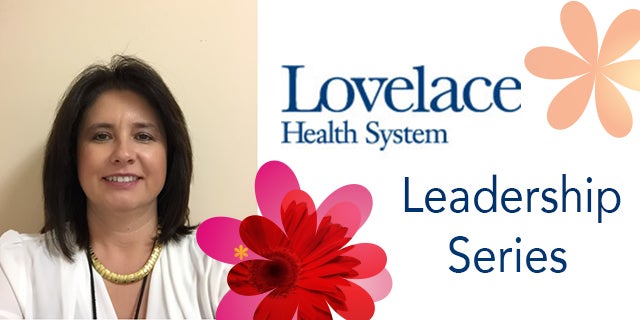
Maria Atencio, RN, is working against the clock. When she joined Lovelace in 1999 in the emergency department at the Heart Hospital of New Mexico at Lovelace Medical Center, she understood the urgency to assess and prepare heart attack patients for intervention as quickly as possible. Every minute mattered. As emergency department charge nurse, Maria coordinated the care for a larger number of heart patients, always mindful and aware of time. In the heart catheterization lab, she worked side-by-side with physicians witnessing the moments lives were saved. It was always a race against time. Did patients listen to early warning signs of a heart attack? Did they wait too long to call 9-1-1?
Today, Maria spends her 40-plus hour work week as the chest pain and STEMI manager for the hospital, as well as extra hours in the community volunteering, to improve the odds for heart attack patients in the race against the clock. Her mission is equal parts prevention and CPR education, and reducing the time that it takes for each heart attack patient that arrives at the hospital to receiving life-saving intervention.
When Maria began her nursing career at the Heart Hospital of New Mexico at Lovelace Medical Center, she knew cardiology was the right fit for her. “I was always attracted to the heart,” she says. “The heart is like the engine in your car. Heart patients come to our hospital and they may be critically ill. We can intervene and many times they are able to walk out of our hospital when they go home.” Seeing that transformation in patients’ health propels Maria on her mission even more.
“80 percent of heart attacks are preventable,” she explains. “People need to pay attention to their bodies.”
Reducing the number of heart attacks and deaths from heart attacks is quite a challenge, but one Maria has made her life’s work. In addition to her efforts at the hospital, Maria co-founded Resuscitation Rangers. The program is made possible through the dedication of 15 hospital employees who volunteer their time outside of work to educate the community on hands-only CPR and the early signs of a heart attack. Since the program’s inception in September of 2015, they have taught more than 2,000 people CPR and how to use an automated external defibrillator (AED).
The results of this work are not as immediate as Maria witnessed in the emergency department or the cath lab. “I’ve had to be patient with myself,” she admits, “to see the impact that we are making to help people.” Yet, in one year’s time, Maria says there are positive indications. “The number of heart attack patients who come to our hospital who called 9-1-1 increased from 25 percent to 56 percent. Before, many heart attack patients were driving themselves or having a relative drive them to the hospital, losing that time and opportunity for earlier intervention. We’ve also decreased the amount of time they are waiting to call 9-1-1 from 143 minutes to 80 minutes.” Maria, medical staff and hospital leadership continue to work to reduce the time it takes for heart attack patients to receive life-saving care. As a result, the Heart Hospital of New Mexico at Lovelace Medical Center has received five national awards.
Maria’s work is more than a career. “I have a personal investment,” Maria shares. “If I can prevent what has happened to my family, then I have made a difference.”
In 2016, Maria organized more than 70 community outreach events teaching the early signs of a heart attack and what to do if you or someone you know is experiencing those signs. At one of those events, Maria was standing in front of an audience of 500 people completely unaware that her sister-in-law went into cardiac arrest 500 miles away. It wasn’t the first time heart attack robbed her family. Her grandfather went to an emergency department experiencing chest pain. For both, time ran out. “These are the sad, unnecessary deaths we can prevent.”
Maria brings that same connection and devotion to her mission to every heart patient and member in the community with whom she encounters in this personal and professional endeavor to save time and lives. “It is a lot of work,” she adds. “But I feel as if I walk around with a smile. I’m energized by the satisfaction of my job. When this role opened up, I knew that I wanted to help people on a larger scale. Our hospital leadership has always supported me. I love what I do.”




